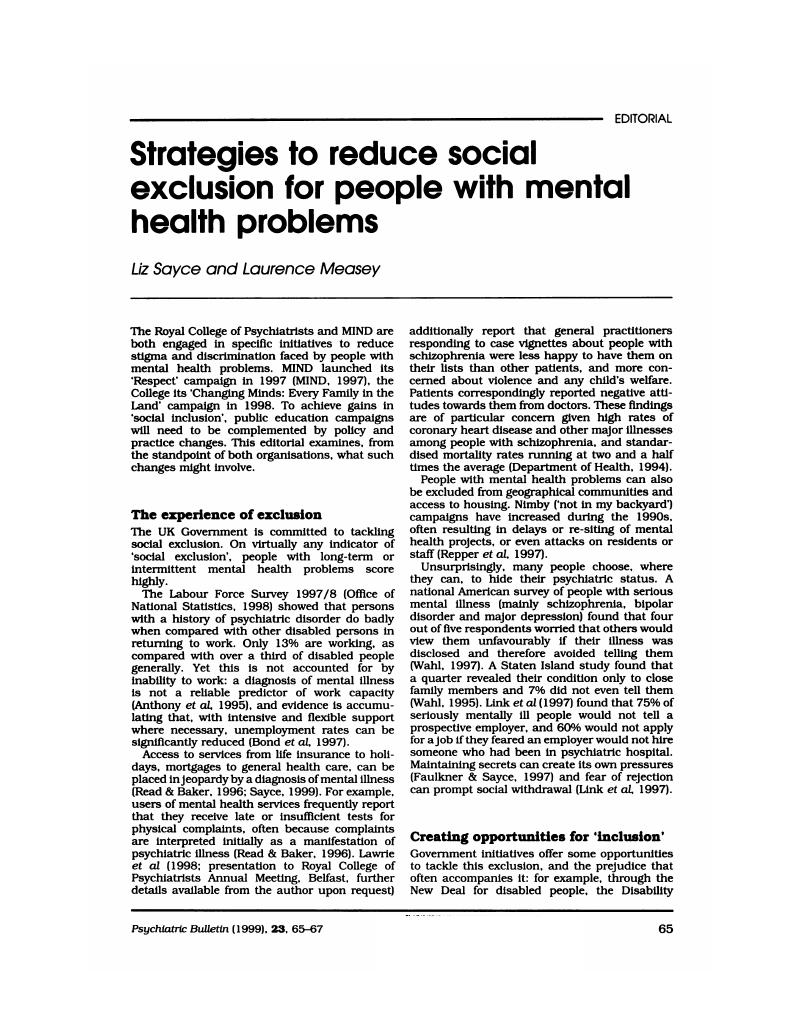Crossref Citations
This article has been cited by the following publications. This list is generated based on data provided by Crossref.
Newbigging, Karen
2001.
Promoting Social Inclusion.
Mental Health Review Journal,
Vol. 6,
Issue. 3,
p.
5.
Sayce, Liz
2001.
Social inclusion and mental health.
Psychiatric Bulletin,
Vol. 25,
Issue. 4,
p.
121.
NASH, M.
2002.
Voting as a means of social inclusion for people with a mental illness.
Journal of Psychiatric and Mental Health Nursing,
Vol. 9,
Issue. 6,
p.
697.
Childs, Sarah
and
Griffiths, Caroline
2003.
Interventions for Mental Health.
p.
202.
Dorer, Gemma
Harries, Priscilla
and
Marston, Louise
2009.
Measuring Social Inclusion: A Staff Survey of Mental Health Service Users' Participation in Community Occupations.
British Journal of Occupational Therapy,
Vol. 72,
Issue. 12,
p.
520.
2009.
Royal College of General Practitioners Position Statement: Mental Health and Primary Care.
London Journal of Primary Care,
Vol. 2,
Issue. 1,
p.
8.
White, Ross
Irving, Susan
and
Clark, Suzy
2009.
Progressing service user involvement in early intervention in psychosis.
Clinical Psychology Forum,
Vol. 1,
Issue. 196,
p.
41.
Charlotte Flinn, Lucinda
Grey, Danielle
and
G. Braham, Louise
2013.
Service user experiences of a motivational group.
Journal of Forensic Practice,
Vol. 15,
Issue. 4,
p.
269.
Bak, Carsten Kronborg
2018.
Definitions and Measurement of Social Exclusion<br/>—A Conceptual and Methodological Review.
Advances in Applied Sociology,
Vol. 08,
Issue. 05,
p.
422.
Mathias, Kaaren
Singh, Prerana
Butcher, Nicole
Grills, Nathan
Srinivasan, Varadharajan
and
Kermode, Michelle
2019.
Promoting social inclusion for young people affected by psycho-social disability in India – a realist evaluation of a pilot intervention.
Global Public Health,
Vol. 14,
Issue. 12,
p.
1718.
Srinivasan, Varadharajan
San Sebastián, Miguel
Rana, Samson
Bhatt, Pooja
Armstrong, Greg
Deshpande, Smita
and
Mathias, Kaaren
2025.
Effectiveness of a resilience, gender equity and mental health group intervention for young people living in informal urban communities in North India: a cluster randomized controlled trial.
Global Health Action,
Vol. 18,
Issue. 1,




eLetters
No eLetters have been published for this article.